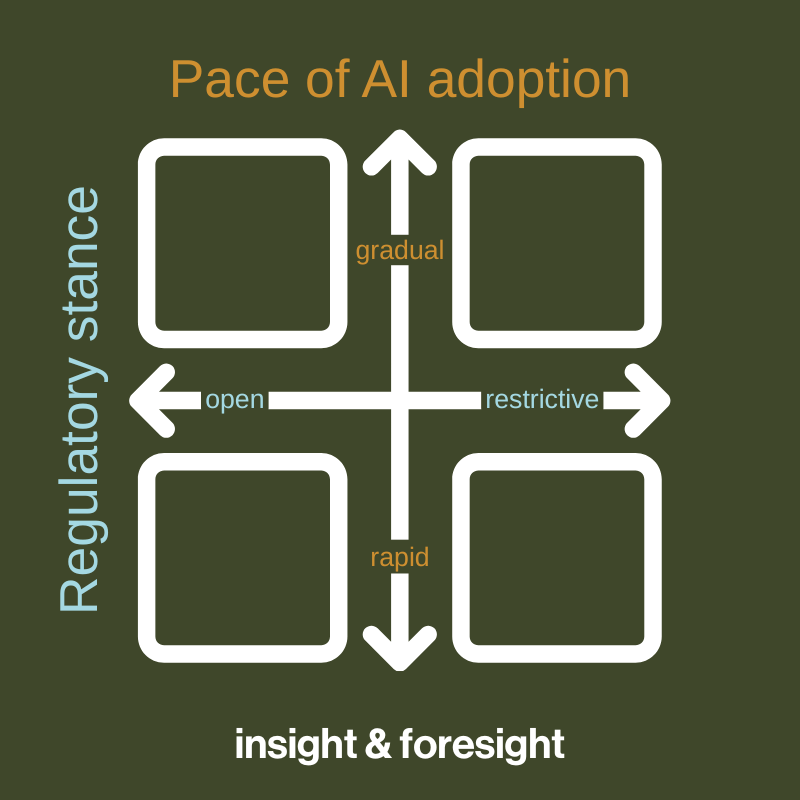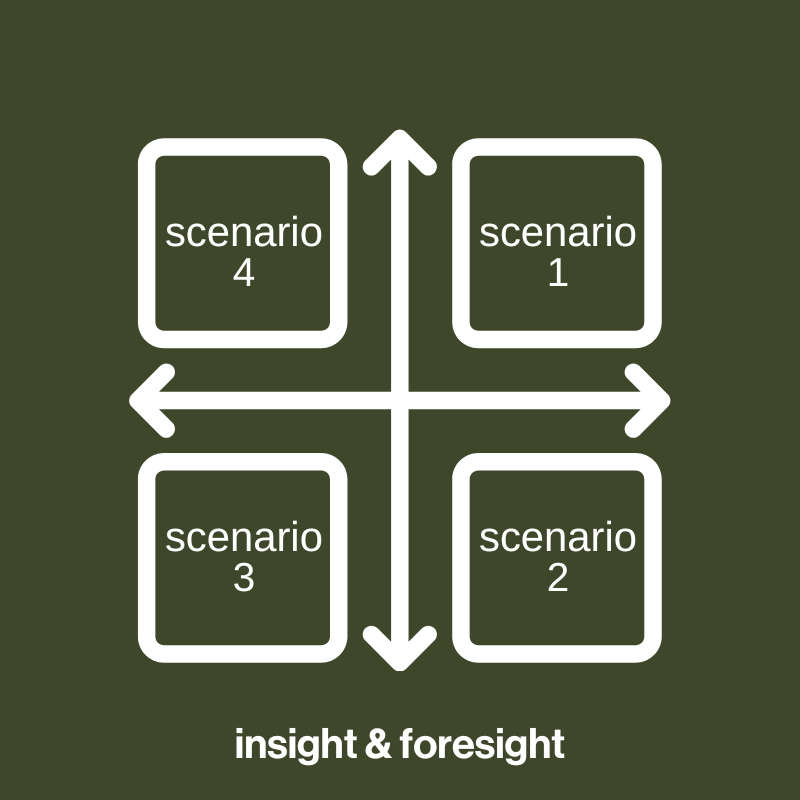Futures Thinking Icon No. 2: Two X Two.
A visual of the 2×2 scenario matrix showing 2 crossed lines creating 4 quadrants
This article is part of our Icons of Futures Thinking.
The 2x2 Scenario Method: A Practical Engine for Futures Thinking.
Senior leaders are making high-stakes decisions with incomplete information. The 2x2 scenario method offers a clear and disciplined way to explore uncertainty, widen strategic options, and align leadership around what might happen next. This post explains what the 2x2 scenario matrix is, where it came from, how it works in practice across industries, and how to use it wisely—recognising both its strengths and its limits—to build robust futures thinking and better decisions.
Key Takeaways:
The 2x2 method maps four plausible futures by crossing two critical uncertainties.
It is fast, visual, and collaborative—ideal for aligning leaders and stress-testing strategy.
It works best when grounded in emerging change data, and paired with ongoing monitoring.
Its simplicity is its power and its limitation; you should use it as a springboard, not a full simulation of futures.
Integrating 2x2 outputs with strategic choices, signals tracking, and portfolio decisions creates real impact.
What is the 2x2 Scenario Matrix?
At its core, the 2x2 scenario method is a framework that generates four distinct futures by crossing two high-impact, high-uncertainty variables. Imagine a grid. The horizontal axis represents one critical uncertainty; the vertical axis represents another. Each quadrant is a different scenario—coherent, plausible, and strategically useful.
For example:
Horizontal axis: Regulatory stance (Open vs. Restrictive)
Vertical axis: Pace of AI adoption (Rapid vs. Gradual)
Result: Four futures ranging from “Open & Rapid” to “Restrictive & Gradual,” each with unique risks, opportunities, and strategic implications.
This structure encourages teams to:
Embrace multiple futures, not a single forecast.
Organise thinking around uncertainties that matter.
Surface assumptions and challenge conventional wisdom.
Where did the 2x2 Come From?
Scenario planning has roots in military strategy and evolved in corporate settings during the late 20th century. General Electric and Royal Dutch Shell popularised scenario planning in the 1970s and 1980s to cope with oil shocks and geopolitical shifts. Practitioners, including Pierre Wack, GBN and Peter Schwartz, helped codify methods for identifying driving forces, selecting critical uncertainties, and crafting narratives.
The 2x2 matrix emerged as a practical, facilitative format within that broader tradition. It proved especially valuable in workshops because it:
Forces focus on the two uncertainties that change strategic choices the most.
Provides a shared visual language for leaders.
Generates a concise set of divergent scenarios without overwhelming participants.
Over time, the 2x2 became a staple in foresight toolkits across consulting firms, policy units, and corporate strategy teams for its speed, clarity, and collaborative value.
Why the 2x2 Matters for Futures Thinking.
Futures thinking is about expanding your field of view, structuring uncertainty, and making better moves today. The 2x2 method:
Encourages divergent thinking before converging on decisions.
Surfaces hidden assumptions by contrasting incompatible futures.
Improves decision agility by rehearsing multiple plausible contexts.
Enables leadership alignment through shared artefacts and common language.
Provides a platform for stress-testing current strategies and spotting option value.
In short, the 2x2 builds mental flexibility. It helps leaders anticipate change and navigate with agility across global, cross-industry dynamics.
How to Build a Strong 2x2.
1) Frame the decision
What decision or strategic choice are you informing? A 2x2 is most useful when anchored to a real choice: where to invest, which capabilities to build, which markets to enter or exit.
2) Scan and synthesise drivers
Gather cross-industry insights: technology, regulation, customer behaviour, macroeconomics, geopolitics, environment, and culture.
Use trend analysis tools and data. Prioritise drivers with clear evidence and momentum.
3) Select the two critical uncertainties
Criteria: high impact on your decision; high uncertainty over your time horizon.
Avoid “false uncertainties” that are already decided by policy or physics.
Test different pairs to see which set meaningfully changes strategic implications.
4) Define axis endpoints clearly
Make endpoints mutually exclusive and collectively exhaustive enough to create diversity.
Use succinct descriptors (e.g., “Data portability: universal vs. walled gardens”).
5) Build four scenario snapshots
Name each quadrant with a memorable label.
Write a short, vivid narrative: what’s happening, who benefits, where value pools shift.
Identify early signals that this scenario may be emerging.
List strategic implications: opportunities, threats, and capability needs.
6) Stress-test strategy and choices
For each scenario, ask: What breaks in our current plan? What thrives?
Define moves that are robust across all four, and options tailored to specific quadrants.
7) Monitor, update, and learn
Convert signals into a dashboard.
Revisit the 2x2 quarterly or when trigger events occur.
Adapt resource allocation as the signal pattern shifts.
Cross-Industry Applications.
Financial Services:
A regional bank could map “Interest Rate Path” (High/Low) against “Regulatory Intensity” (Tight/Loose). The scenarios guided capital allocation between fixed-income products, digital onboarding, and compliance capabilities. They also identified a hedging strategy for a tightening/low-rate quadrant that previously lacked attention.
Healthcare and Life Sciences:
A biotech could use “Clinical AI Adoption” (Rapid/Gradual) versus “Payer Pricing Power” (High/Low). The resulting scenarios shaped its clinical data platform investments and market access strategy. In one quadrant—Rapid AI + High Payer Power—the company pursued partnerships to integrate diagnostic AI with payers’ utilisation management, de-risking reimbursement.
Consumer Goods:
A global CPG brand could cross “Sustainability Regulation” (Strict/Light) with “Consumer Frugality” (High/Low). Scenarios informed packaging innovation, SKU rationalisation, and pricing architecture. Under Strict + High Frugality, the team prioritised refill systems and private-label collaboration to protect share while meeting compliance.
Energy and Utilities:
An energy retailer could map “Grid Flexibility” (High/Low) against “Carbon Price” (High/Low). The analysis highlighted investment options in demand response, advanced metering, and long-duration storage. In High Carbon + Low Flexibility, the company accelerated PPAs with firm low-carbon sources to stabilise margins.
Higher Education:
A university could examine “Credential Portability” (Open/Closed) vs. “Workforce Upskilling Demand” (High/Moderate). Outcomes informed micro-credential programs, partnerships with employers, and a global digital campus strategy.
Public Policy and Cities:
A city council could use “Migration Flows” (Rising/Volatile) against “Housing Supply Elasticity” (High/Low). Scenarios shaped zoning reforms, modular housing pilots, and local services planning to reduce service strain under Low Elasticity.
Each example uses the 2x2 to connect external uncertainty to practical moves—capabilities, partnerships, investments, and policy levers—supporting agility and leadership alignment.
Strengths of the 2x2 Method.
Simplicity that scales: The visual format is easy to grasp across disciplines and cultures. It works in a half-day workshop and in boardroom strategy sessions.
Fast divergence: Four distinct worlds break the habit of single-point forecasting. You get diversity of futures without analysis paralysis.
Focus on what matters: Selecting the two most critical uncertainties forces prioritisation and reduces noise.
Collaborative alignment: The 2x2 creates a shared language and artefact. It helps unify perspectives across finance, operations, risk, technology, and marketing.
Action orientation: It naturally leads to stress-testing, identifying no-regret moves, and designing real options linked to scenarios.
Limitations and How to Mitigate Them.
No interaction among more than two variables: Real systems are multi-causal. Mitigation: Use the 2x2 as a front door, then deepen analysis with system maps, causal loops, or agent-based explorations for key scenarios.
Risk of oversimplification: Endpoints can be too binary. Mitigation: Define clear endpoints but describe gradients within narratives; include indicators and thresholds.
Anchoring bias in axis selection: Teams may pick familiar uncertainties, not the truly critical ones. Mitigation: Start with a broad scan, include external voices, and run a quick “axis shootout” to compare candidate pairs.
Static snapshots: Futures evolve; scenarios can become stale. Mitigation: Attach signals, set review cadences, and update the matrix when the signal pattern shifts.
Story over evidence: Narratives can drift away from data. Mitigation: Ground each scenario in trends, data points, and cross-industry evidence; cite assumptions openly within the team (even if not in the public output).
Making the 2x2 Operational.
To convert insights into strategic value:
Identify robust moves: Actions that pay off in all four scenarios (e.g., data interoperability, cybersecurity, leadership development).
Create options tied to specific futures: Small bets or staged investments that can scale when certain signals appear.
Build trigger points: Decide in advance what signal thresholds will activate a pivot or scale-up.
Align portfolios: Map current initiatives against the matrix to balance risk and return.
Communicate clearly: Use concise scenario summaries, one-page visuals, and a shared vocabulary across leadership.
Train teams: Build futures thinking skills across functions so scenario use is routine, not an annual ritual.
Start Now: A Rapid Workshop Flow.
Pre-work: Collect trend scans, regulatory outlooks, customer insights, and financial sensitivities.
Define the decision and time horizon; clarify success measures.
Identify drivers; shortlist uncertainties; vote on the top two.
Define axis endpoints; draft scenario names and narratives.
For each scenario, list 5–7 strategic implications and early signals.
Identify robust moves, options, and immediate next steps; assign owners.
This rhythm creates momentum and tangible outputs leaders can use.
How the 2x2 Builds Stronger Futures Thinking.
The 2x2 is not just a tool; it’s a habit-forming device. It:
Normalises plurality: There is more than one plausible future.
Encourages disciplined curiosity: Leaders ask better questions about drivers and signals.
Strengthens decision agility: Teams practice shifting plans as contexts change.
Improves strategic flexibility: Portfolios reflect a spread of outcomes, not a single bet.
Enhances leadership alignment: Shared understanding reduces friction when change arrives.
Using the 2x2 to Navigate Uncertainty.
The 2x2 scenario method gives leaders a fast, credible way to embrace the unknown, generate cross-industry insights, and make strategic choices with confidence. Its simplicity helps you move from debate to decision. Its limitations are manageable when you ground it in data, revisit it often, and connect it to real options and trigger points.
Get started quickly by:
Pick a priority decision with a 3–5 year horizon.
Run a focused 2x2 workshop using evidence-backed drivers.
Translate outputs into robust moves, options, and triggers.
Establish a signals dashboard and a quarterly review.
Repeat as markets shift, regulations evolve, or technology disrupts.
Used this way, the 2x2 method becomes a reliable companion for strategic planning and decision-making—clarifying choices, sharpening risk management, and building the leadership agility needed to thrive in uncertain environments.
References:
Curry, Andrew. (2012). The Scenarios Question. In book: The Future of Futures (Association of Professional Futurists, 2012) Publisher: Association of Professional Futurists Editors: Andrew Curry
Curry., A และ Schultz, W., (2009). “ถนนที่ผู้คนเดินทางน้อยลง: วิธีการที่แตกต่าง อนาคตที่แตกต่าง” Journal of Futures Studies, 13(4): 35-60
Rhydderch, Alun. (2017). การสร้างสถานการณ์: เทคนิคเมทริกซ์ 2x2
Schwartz, P., (1996). The Art of the Long View. นิวยอร์ก: Doubleday
Wack, P. (1985a). “สถานการณ์: อนาคตที่ยังไม่ชัดเจน” Harvard Business Review, กันยายน 1985, 73-89
Wack, P. (1985b). “สถานการณ์: การยิงน้ำเชี่ยว” Harvard Business Review, พฤศจิกายน 1985, 139-150


